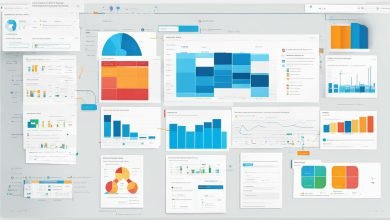As more and more companies shift towards cloud computing, they are discovering the benefits of decoupling their applications. Decoupling applications in the cloud can help improve scalability, enable real-time messaging, and enhance the overall performance of cloud solutions. However, achieving a decoupled architecture can be a daunting task. That’s where Azure Event Grid and C# Microservices come in.
Azure Event Grid is a powerful event routing service that can help decouple different components of a cloud application. It provides reliable event delivery between different services, enabling loose coupling between them.
C# Microservices, on the other hand, allow developers to create modular and independent components that can communicate with each other using event-driven architecture. This makes it easier to develop, test, and deploy cloud applications at scale.
In this article, we will explore how Azure Event Grid and C# Microservices can be used to decouple applications in the cloud. We will also provide practical guidance on how to build scalable applications using these technologies and other Azure services.
Key Takeaways:
- Decoupling applications in the cloud can improve scalability and enable real-time messaging.
- Azure Event Grid is a powerful event routing service that can help decouple different components of a cloud application.
- C# Microservices allow developers to create modular and independent components that can communicate with each other using event-driven architecture.
- Together, Azure Event Grid and C# Microservices can help build efficient and scalable cloud solutions.
Understanding Cloud Application Architecture
Cloud application architecture is essential for building scalable and flexible applications that can adapt to changing requirements and usage patterns. It provides a foundation for decoupling applications in the cloud, allowing different components to operate independently while communicating with each other through well-defined interfaces.
Decoupling applications in the cloud involves breaking down large monolithic applications into smaller, independent services that can be scaled and deployed separately. This approach enables faster development, easier maintenance, and better fault tolerance.
Event-driven architecture is a key principle of cloud application architecture that facilitates decoupling. It involves building applications around the idea of events that trigger actions in different services. This allows each service to operate independently and asynchronously, without being tightly coupled to other services.
Azure services, such as Azure Event Grid, provide the infrastructure for implementing decoupled architectures in the cloud. Azure Event Grid allows services to publish and subscribe to events, enabling reliable event delivery between different services. This eliminates the need for custom code or polling mechanisms and provides a scalable and fault-tolerant event distribution system.
Key Concepts of Cloud Application Architecture
Cloud application architecture involves the following key concepts:
- Modularity: Applications should be built as a collection of independent services that can be developed, deployed, and scaled separately. This enables faster development, easier maintenance, and better fault tolerance.
- Service Interfaces: Services should expose their functionality through well-defined interfaces, allowing other services to communicate with them in a consistent and predictable manner.
- Event-driven architecture: Applications should be built around events that trigger actions in different services. This allows each service to operate independently and asynchronously, without being tightly coupled to other services.
Azure services, such as Azure Event Grid, provide the infrastructure for implementing decoupled architectures in the cloud. Azure Event Grid allows services to publish and subscribe to events, enabling reliable event delivery between different services.
Introduction to Azure Event Grid
When it comes to decoupling applications in the cloud, Azure Event Grid is a critical component to consider. Azure Event Grid is a fully managed event routing service that enables event-driven communication between different services, both within and outside of Azure. It acts as an intermediary between different components of a cloud application, allowing them to communicate in a decoupled manner.
By using Azure Event Grid, developers can build cloud applications that are more scalable, flexible, and responsive to real-time changes. This is because Azure Event Grid provides reliable event delivery, which is essential for implementing event-driven architectures. The event-driven architecture is an approach to building cloud applications that emphasizes loose coupling between different components, allowing them to operate independently and without direct dependencies.
Furthermore, Azure Event Grid is part of the larger Azure ecosystem, which means it can integrate seamlessly with other Azure services to create powerful solutions. This includes services such as Azure Functions, Azure Logic Apps, and Azure Service Bus, which can enhance the capabilities of Azure Event Grid by providing additional features and functionality.
In summary, Azure Event Grid is a powerful tool for decoupling applications in the cloud, enabling event-driven architecture, and building scalable cloud solutions. Its integration with other Azure services makes it a versatile component that can be used in a wide range of cloud computing scenarios.
Leveraging C# Microservices for Decoupling
In cloud computing, decoupling is an essential principle for achieving scalable and flexible applications. C# Microservices provide a powerful tool for structuring cloud-based solutions into tightly defined, independent components. Microservices communication requires an event-driven architecture to ensure that all components work together seamlessly, and that’s where Azure Event Grid comes in.
C# Microservices are modular, independent components that can be developed, deployed and scaled independently. The decoupling feature of C# Microservices enables each service to work independently, without affecting other components in the system. Microservices communication, however, requires something more than just HTTP requests and responses. Event-driven communication is a powerful way to ensure that all components work together seamlessly.
Azure Event Grid is an event routing service that makes it easy to harness the power of events in the cloud. Azure Event Grid provides a reliable, scalable and flexible platform for managing events and works well with C# Microservices. The decoupling feature of C# Microservices allows them to publish events on Azure Event Grid and subscribe to events produced by other components. This approach to Microservices communication ensures that each C# Microservice can work independently without knowing about the other components in the system.
Event-driven architecture is a key component of microservices communication, and Azure Event Grid provides the perfect platform for implementing this approach. By leveraging Azure Event Grid for event-driven communication, each C# Microservice can receive events in real-time, can update its state, and can trigger actions based on changes in the system. The decoupling feature of C# Microservices ensures that each component can work independently, without affecting other components in the system.
By leveraging C# Microservices and Azure Event Grid, cloud-based solutions can be built with highly decoupled and scalable architectures. The use of event-driven communication ensures that each component can work independently and that the entire system can scale to handle the most demanding workloads. The result is a cloud-based solution that is highly flexible, scalable, and efficient.
Building Scalable Applications with Azure Event Grid and C# Microservices
When it comes to building scalable applications in the cloud, decoupling your architecture is key. By breaking down application components into smaller, more modular services, you can increase scalability and improve the overall resilience of your system. Combining Azure Event Grid and C# Microservices allows you to achieve highly decoupled architectures that can handle even the most demanding workloads.
One of the most important principles of building scalable applications is designing for event-driven communication patterns. By using Azure Event Grid, you can achieve reliable event delivery between different services in your application. Azure Event Grid is a fully managed event routing service that can handle millions of events per second. It provides real-time messaging with automatic scaling, making it ideal for building highly scalable cloud applications.
C# Microservices are also a key component for decoupling in the cloud. By breaking down your application into smaller, more modular services, you can achieve better scalability and resilience. C# Microservices allow you to create independent components that can be developed and deployed separately, without impacting the rest of the application. By leveraging Azure Event Grid, C# Microservices can communicate with each other in real-time, enabling a highly responsive and decoupled architecture.
When building scalable applications with Azure Event Grid and C# Microservices, it’s important to consider the overall cloud application architecture. Decoupling your application involves breaking down your architecture into smaller, more modular services. This can involve using other Azure services, such as Azure Functions, Azure Logic Apps, and Azure Service Bus, to enhance the capability of your system.
Real-time messaging is also crucial for building highly scalable cloud applications. By using Azure Event Grid and C# Microservices, you can achieve a real-time, event-driven architecture that can handle even the most demanding workloads. This approach is highly scalable, flexible, and resilient, making it ideal for building applications that can scale with your business.
Exploring Azure Services for Decoupling Applications
While Azure Event Grid and C# Microservices are powerful tools for achieving decoupling in cloud applications, they are not the only options available. Azure offers a range of services that can enhance the decoupling capabilities of cloud applications and provide additional benefits.
Azure Functions
Azure Functions is a serverless compute service that enables developers to run code on demand. By using Azure Functions in conjunction with Azure Event Grid, developers can easily create decoupled architectures that respond to events in real-time. Azure Functions can also be used to process data, integrate with other Azure services, and handle background tasks.
Azure Logic Apps
Azure Logic Apps is a workflow automation tool that enables developers to create scalable and reliable workflows. By using Azure Logic Apps with Azure Event Grid, developers can build highly decoupled architectures that automate business processes, integrate with external systems, and respond to events in real-time.
Azure Service Bus
Azure Service Bus is a messaging service that enables reliable and secure communication between different components of a cloud application. By using Azure Service Bus in conjunction with Azure Event Grid and C# Microservices, developers can build scalable and decoupled architectures that enable asynchronous communication, message queuing, and publish/subscribe messaging.
By leveraging these and other Azure services, developers can create cloud applications with highly decoupled architectures that provide improved scalability, reliability, and performance. The combination of Azure services, C# Microservices, and Azure Event Grid provides a powerful toolkit for building cloud applications that can handle any workload.
Conclusion
In today’s cloud computing landscape, decoupling applications is an essential practice for building scalable and flexible solutions. Azure Event Grid and C# Microservices are two powerful tools that can help achieve this goal.
By leveraging Azure Event Grid, cloud architects and developers can implement a reliable event-driven architecture that enables loose coupling between different components. C# Microservices, on the other hand, enable the creation of modular and independent components that can communicate with each other using Azure Event Grid.
This article has provided an overview of the importance of decoupling applications in the cloud and how Azure Event Grid and C# Microservices can help achieve this goal. We have discussed the benefits of decoupled architectures, such as scalability and real-time messaging. We have also explored other Azure services that can be used in conjunction with Azure Event Grid and C# Microservices, such as Azure Functions, Azure Logic Apps, and Azure Service Bus.
Decoupling applications in the cloud is not an easy task, but it is a necessary one for building resilient and efficient solutions. With Azure Event Grid and C# Microservices, developers can take advantage of a powerful combination of tools that enable the creation of highly decoupled and scalable cloud applications.
FAQ
Q: What is decoupling applications in the cloud?
A: Decoupling applications in the cloud refers to the process of reducing dependencies between different components of a cloud application. It involves designing the application in a way that allows each component to function independently, enabling scalability, flexibility, and improved performance.
Q: How can Azure Event Grid help in decoupling applications?
A: Azure Event Grid is a service provided by Microsoft Azure that enables reliable event delivery between different services. It allows applications to send and receive events, facilitating the decoupling of components and enabling scalable and flexible architectures.
Q: What are C# Microservices?
A: C# Microservices are modular and independent components of a cloud application that are built using the C# programming language. They enable the implementation of decoupled architectures by allowing each microservice to operate independently while communicating with each other through events using Azure Event Grid.
Q: What are the benefits of decoupling applications in the cloud?
A: Decoupling applications in the cloud offers several benefits, including improved scalability, flexibility, and real-time messaging. It allows components to be scaled independently, enables easier integration of new functionalities, and facilitates seamless communication between different services.
Q: How can I build scalable applications with Azure Event Grid and C# Microservices?
A: To build scalable applications with Azure Event Grid and C# Microservices, it is important to follow best practices such as using event-driven communication patterns and leveraging the scalability features of Azure Event Grid. This ensures that the application can handle increased loads and adapt to changing requirements.
Q: What other Azure services can be used for decoupling applications?
A: There are several other Azure services that can be used in conjunction with Azure Event Grid and C# Microservices for decoupling applications. Some examples include Azure Functions, Azure Logic Apps, and Azure Service Bus. These services enhance the decoupling capabilities of cloud applications and enable the creation of highly scalable and flexible architectures.







